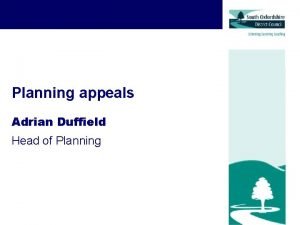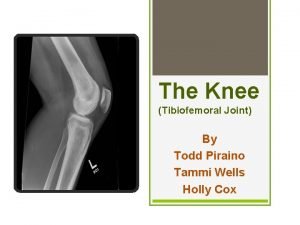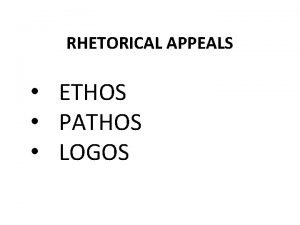Planning appeals Adrian Duffield Head of Planning Topics












- Slides: 12

Planning appeals Adrian Duffield Head of Planning

Topics 1. What is an appeal and what form can it take? 2. 3. 4. 5. Who can appeal? 6. What’s in the pipeline & how we will respond 7. Questions Costs of appeals SODC’s success rate Recent inspector’s decisions and emerging themes 2

Background • Appeals are made to the Planning Inspectorate (PINS) & determined by an appointed Inspector or the Secretary of State • Can only be lodged by an applicant • Can be against the refusal of planning permission, a condition imposed of a planning permission, an enforcement notice or the non determination of a planning application within the statutory target 3

Types of appeals • Written representations – most common, cheapest and quickest average timescale eight weeks • Hearings – formal discussion led by the Inspector, can involve legal representation, technical experts and third parties - timescale 14 weeks • Public Inquiries – most expensive, both sides usually have a barristers – timescale 14 - 22 weeks 4

Costs • Costs can be awarded against the LPA, the appellant, statutory consultees and interested parties • Reasons for costs can be procedural or substantive. Grounds can include lack of cooperation between the parties, delays, the introduction of new/ late evidence, failing to notify interested parties, unreasonable behaviour and failure to substantiate refusal reasons 5

Challenges • Judicial Review can be brought by any party but only on point of law • Has to be made within six weeks of decision date • Recent example at Shiplake 6

Success rate • National average = 68% • SODC current success rate = 48% • Number of appeals is rising • 2014/15 – 60 • 2015/16 – 50 so far including one public inquiry • Four inquiries scheduled between January and April. Further three to be agreed 7

Recent public inquiries • Shiplake • Benson • Woodcote • Chinnor x 2 • More inquiries in the pipeline – Wallingford, Chinnor, Stadhampton & Tetsworth 8

Key issues raised in the appeals • Challenging our 5 year supply of housing and the ring fencing of Didcot (Shiplake, Woodcote and Chinnor) • Challenging that our development plan is silent on where the homes in larger villages will go (Benson and Chinnor) 9

Actions • SHMA prompted a review of our Core Strategy • Now preparing Local Plan 2031 • Actively encouraging our larger villages to pursue Neighbourhood Plans 10

Risks and mitigation • Expecting more applications and appeals • Need to work proactively on allocated sites & determine applications promptly • Need to work with parishes, through Neighbourhood Plans where appropriate, to bring forward housing sites to maintain delivery 11

Questions • Any questions? 12























